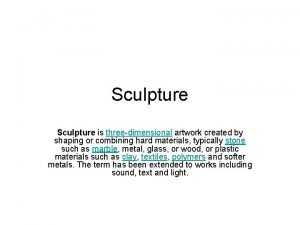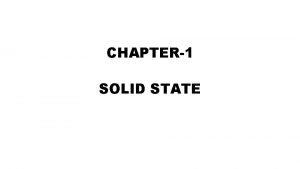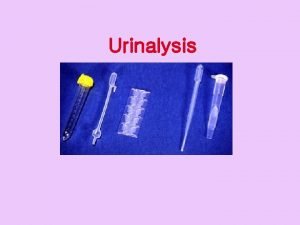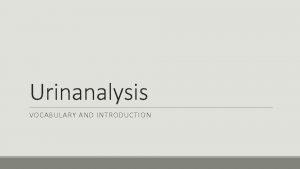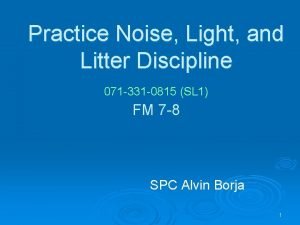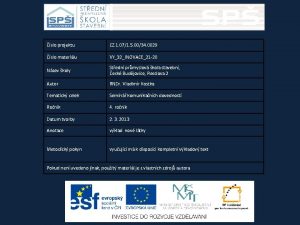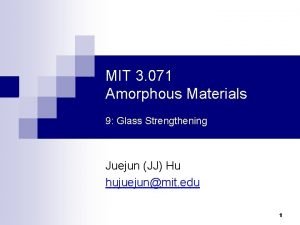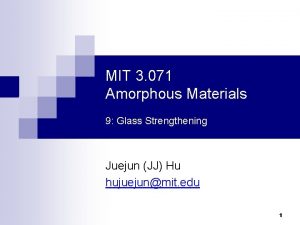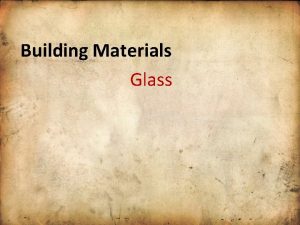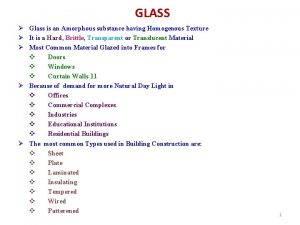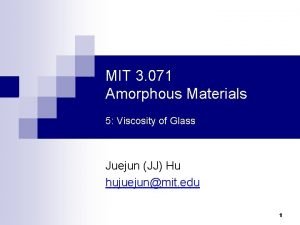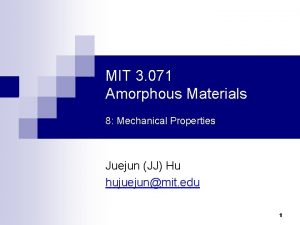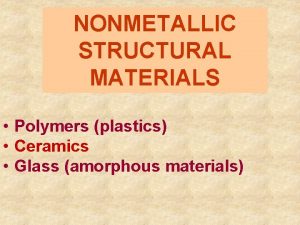MIT 3 071 Amorphous Materials 6 Glass Shaping































- Slides: 31

MIT 3. 071 Amorphous Materials 6: Glass Shaping Juejun (JJ) Hu hujuejun@mit. edu 1

After-class reading list n Fundamentals of Inorganic Glasses ¨ n Ch. 20 Introduction to Glass Science and Technology ¨ Ch. 13 2

“Viscosity makes things happen essentially in slow motion. If you are trying to melt a crystalline solid (like ice or an aluminum oxide ceramic), as soon as you reach the melting point, a drop of liquid forms and falls away from the melting surface. Glass, on the other hand, … gradually transforms from a hard solid to a slowly softening liquid. This soft liquid gradually stiffens as it cools (because of its increasing viscosity), allowing glass blower time to shape and manipulate the glass. ” http: //madsci. org/posts/archives/2007 -09/1188944613. Ph. r. html 3

Viscosity reference points PGM Working range Glass blowing Fiber drawing Lehr annealing Float glass Pitch: 2. 3 × 108 103 101 Melting Working point 106. 6 Softening point 1013. 5 h (Pa·s) 1012 Annealing Straining point (Tg) point 4

Basic properties of common silicate glasses Soda-lime Borosilicate Fused silica CTE (ppm/°C) 9. 2 3. 2 0. 5 Working point (°C) 1005 1252 N/A Softening point (°C) 696 821 1650 Annealing point (°C) 510 560 1140 Strain point (°C) 475 510 1070 5

Early flat glass process: crown glass n Crown glass was produced by making a hole in a molten glass bubble, then spinning the glass to create a flat, circular sheet with a distinctive “bulls-eye” pattern 6

Flat glass manufacturing: float glass process n Forming of a continuous ribbon of glass using a molten tin bath ¨ Melting and refining (homogenization and bubble removal) ¨ Float bath: glass thickness controlled by flow speed ¨ Annealing: stress release ¨ Inspection, cutting and shipping 101 Pa·s 102. 5 Pa·s 1012 Pa·s > 1015 Pa·s 7

8

Flat glass manufacturing: down-draw methods n Preserves pristine surfaces: no subsequent polishing required n Broad range of thicknesses from millimeter to tens of microns n Mostly used for flat panel display glasses 9

Glassblowing Gaffer Parison Blow pipe 10

Glass container production n Narrow-neck containers (e. g. , bottles): blow-and-blow process n Wide-mouthed jars: press-and-blow process http: //www. beatsonclark. co. uk/

Glass container production 12

Glass caneworking n Canes: thin glass rods (often with color); can be of a single color, or contain multiple strands arrayed in a pattern (murrine) n Basic glass work technique for adding intricate stripe patterns to glassware or blown glass Gather glass with pontil Gob shaping on marver Cane drawing Stack and bundle 13

Glass caneworking Reticello Millefiori Zanfirico 14

Stability of drawn cane structures n Are you breaking my lovely canes? s s s l-times system size Same strain rate! s 15

Stability of drawn cane structures Cane diameter D change: Necking develops if viscosity is independent of diameter D F, s Are you breaking my lovely canes? F, s /l 2 F, s l-times system size F, s /l 2 16

Stability of drawn cane structures Stability threshold: F, s Are you breaking my lovely canes? F, s /l 2 F, s l-times system size F, s /l 2 17

Stability of drawn cane structures Now consider heat dissipation: n Radiative heat transfer dominates n Stefan-Boltzmann law Heat flux: Are you breaking my lovely canes? e : emissivity s = 5. 67 × 10 -8 W/m 2 K 4 n Temperature change rate n Viscosity dependence on temperature High T range 18

Modeling outcome Assumptions: n Uniform temperature distribution along the cane cross-section n No heat or mass exchange between cane sections n n Only considers radiative heat transfer from glass cane to the surroundings F T 1 T 2 Constant drawing speed 19

Modeling outcome Conclusions: n Thinner section cools faster n Viscosity increase in thinner section prevents necking n Cane diameter nonuniformity damps out It works beautifully! F D 1 D 2 20

Precision glass molding (compression molding) n Viscosity: 106. 6 – 108 Pa·s; pressure: ~ MPa n Mold sticking and damage: Ti. N or Si. C low friction coatings n Non-uniform temperature distribution n Post-molding deformation: thermal shrinkage, viscoelasticity http: //www. rpoptics. com/wp-content/uploads/2015/01/Precision-Glass-Molding-Technical-Brief_21. pdf 21

PGM glass asphere lens LFW 47, 42 -45 (2011) 22

3 -D glass printing 23

Mechanical properties of bulk metallic glass (BMG) Polycrystalline metal Amorphous metal Grain boundaries Crystal planes n n Metals 3, 1 (2013). Absence of dislocations and slip planes/directions in BMG ¨ Large elastic limit and high yield strength (2% and 2 GPa in Zr-based BMGs) ¨ Poor global plasticity: absence of strain hardening, strong tendency towards shear localization Cold working is not a viable processing solution 24

Mechanical properties of a commercial BMG Data from Liquidmetal® Technologies ü High yield strength, hardness, and elasticity 25

BMG process design Casting n Data from Liquidmetal® Technologies Casting: suction casting, die casting ¨ Reduced volume shrinkage (< 1%): net-shape forming ¨ Cooling rate control: mold filling and crystallization mitigation 26

BMG process design Thermoplastic forming (TPF) n Scripta Mater. 60, 160 (2009). Thermoplastic forming: compression & injection molding, extrusion, rolling, blow molding, 3 -D printing ¨ Thermal embrittlement: free volume decrease 27

BMG process design Thermoplastic forming (TPF) Adv. Mater. 22, 1566 (2010). n Glass-forming liquid fragility ¨ Liquids with low fragility have better temperature tolerance 28

Compression molding Sample size Shape Aspect ratio Issues mm to cm Open structures 1 to 10 Mold release and mold wear Adv. Mater. 22, 1566 (2010) 29

Injection molding Sample size Shape Aspect ratio Issues mm to cm Open structures 1 to 10 Mold release and mold wear 30

Blow molding Parison Final shape Sample size Shape Aspect ratio Issues 10 mm to cm Hollow shapes 10 to 1, 000 Temperature control, mold sticking Materials Today 14, 14 (2011) 31
 Sculpture is created by shaping or combining the materials
Sculpture is created by shaping or combining the materials Urine
Urine Crystalline solid and amorphous solid
Crystalline solid and amorphous solid Amorphous disk mark
Amorphous disk mark Amorphous solid simple definition
Amorphous solid simple definition Is cotton candy anisotropic
Is cotton candy anisotropic Amorphous urate
Amorphous urate Crystallography types
Crystallography types Shapeless formless vague
Shapeless formless vague Microscopic analysis of urine
Microscopic analysis of urine Amorphous
Amorphous Crystalline solids
Crystalline solids Fauvism pronunciation
Fauvism pronunciation Chem
Chem Bcd addition of 184 and 576
Bcd addition of 184 and 576 071 atm code
071 atm code Employ hand grenades
Employ hand grenades Light and noise discipline
Light and noise discipline React to indirect fire while dismounted
React to indirect fire while dismounted 071-com-0804
071-com-0804 071-com-0029
071-com-0029 Pb071
Pb071 Foo2123
Foo2123 071-com-4407
071-com-4407 Major terrain features
Major terrain features N 3^071
N 3^071 Glass escalator concept
Glass escalator concept Does hot glass look the same as cold glass
Does hot glass look the same as cold glass Does hot glass look like cold glass
Does hot glass look like cold glass Adapting and adopting materials
Adapting and adopting materials Go noodle cant stop the feeling
Go noodle cant stop the feeling Direct materials budget with multiple materials
Direct materials budget with multiple materials
